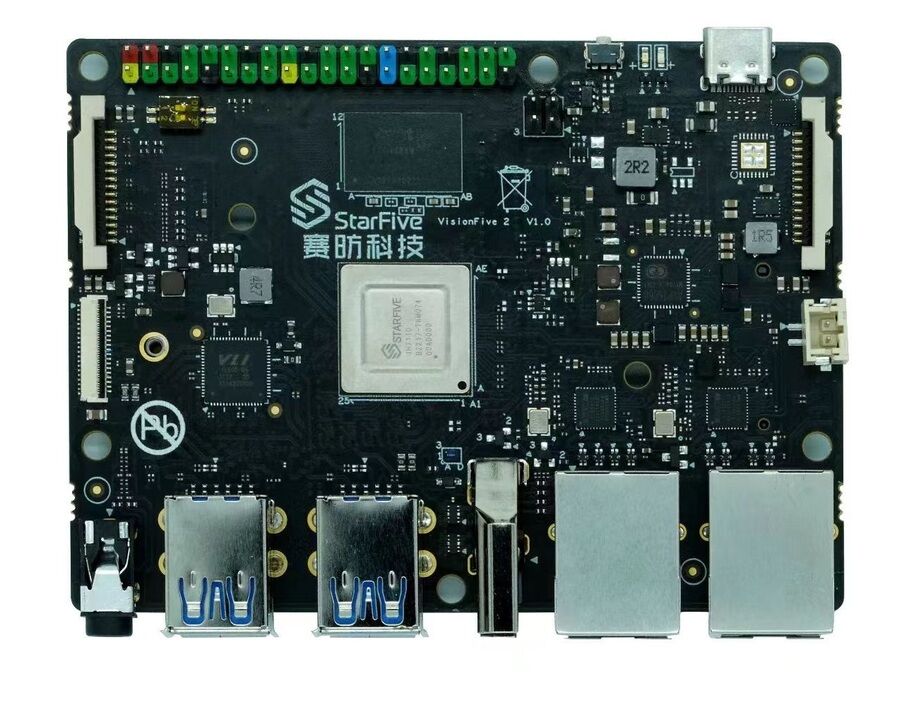VisionFive 2: A Raspberry Pi Like Moment for RISC-V
The VisionFive 2 is a new RISC-V System-on-a-Chip (SoC) board that offers powerful performance (somewhere between RPi 3 and RPi 4) and low cost. Until now most of the powerful RISC-V systems were much more expensive and out of reach of most of us. This new board features a quad-core processor with a clock speed of 1.5GHz, 2GB of LPDDR4 RAM (there is also 4GB and 8GB RAM versions available) and an eMMC storage and TF card slot.

It also has Gigabit Ethernet, USB 3.0, and HDMI ports, as well as support for WiFi and Bluetooth. The board costs about $99 and can be found among many retailers, such as AmeriDroid in the US. Note that the eMMC storage only has a single lane so you won’t reach super high speeds with it.

Why RISC-V Matters
One advantage of RISC-V is that it does not come with the licensing restrictions of proprietary ISAs like ARM. This allows developers to have full control over their designs and to use them in a way that best suits their needs. This is particularly important for those looking to commercialize their designs and bring products to market. It also allows for a more dynamic and adaptable technology that can evolve as per the needs of the community and industry.
The RISC-V ISA is being widely adopted in the industry, from small startups to large corporations. For example, Western Digital has announced that it is transitioning its entire product line to RISC-V, and Google has announced that it is using RISC-V in its data centers. They may also be experimenting with RISC-V to run Android on for future mobile phones. Furthermore, RISC-V is also gaining traction in the Internet of Things (IoT) and embedded systems market, with companies such as SiFive, Microchip and NXP Semiconductors releasing RISC-V based products.
The VisionFive 2’s is the first board that hits a sweet spot between features, performance and price point. This may very well be the Raspberry Pi moment for RISC-V, in 2023. From there on you can expect more devs to bring this board support closer to mainline Linux, and while the GPU driver is likely still going to be a binary blob, that does not prevent the usage of this board in server-like applications.
VisionFive 2: The Software Part
Now the biggest work ahead is going to be about porting software for this new architecture. You already have a full Debian distribution running on this board, but that does not mean that every single software can be compiled as of yet. Even in FOSS, there are still many piece of software that rely on specific bits of code for each architecture (X86_64, ARM64) and that would require some adaptation for RISC-V. But the future is nevertheless bright. It’s moving much faster than I had expected, and we could have usable Linux distributions to do a variety of tasks very, very soon.
There was a very recent post where someone reported trying to move to a more recent version of Debian by using the bits provided by StarFive on their Debian image. The conclusion there is that RISC-V has no mainline support yet, but it should be coming from Linux 6.3, which is not too far away from now. When this happens it’s likely that you will be able to see pretty much any distribution support RISC-V with very little effort.
Gaming-wise, it’s already possible to play with Quake - and it’s likely that several other ports of popular engines will make it to the platform soon:
When I talked with the creator of Box86/Box64 in December, he mentioned that he would likely try to also support RISC-V in the near future, which means that running x86_64 games is not so far off either. Exciting times for RISC-V!
